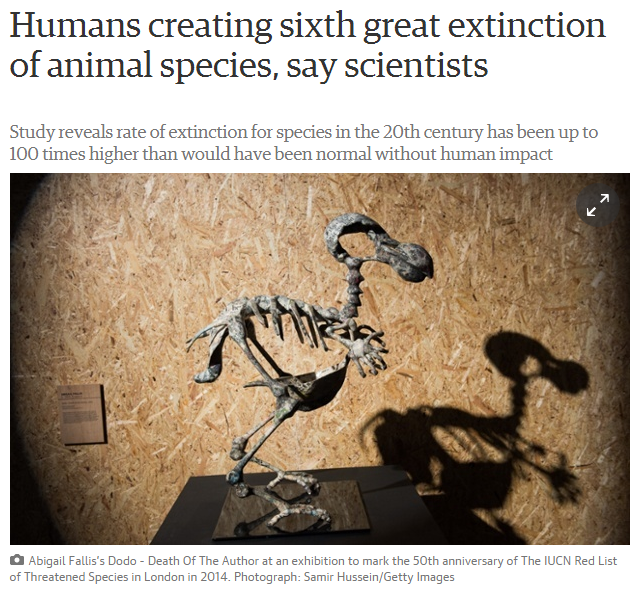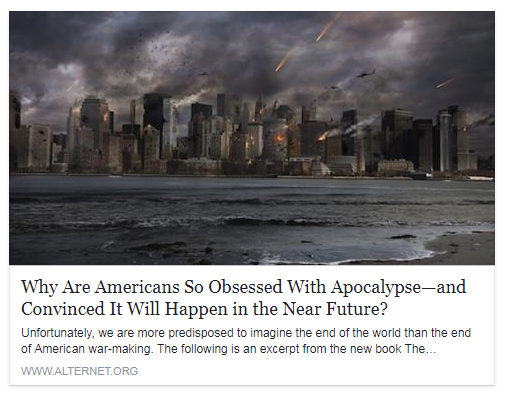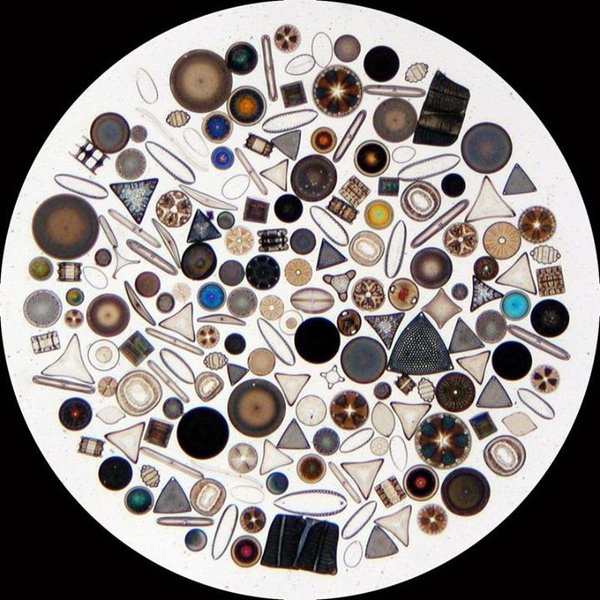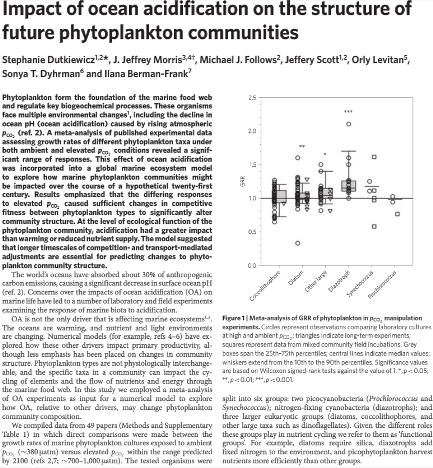Extinction: Difference between revisions
Siterunner (talk | contribs) No edit summary |
Siterunner (talk | contribs) No edit summary |
||
| Line 9: | Line 9: | ||
:<big>''[[Apocalyptic Thinking]]''</big> | :<big>''[[Apocalyptic Thinking]]''</big> | ||
:: * ''https://www.greenpolicy360.net/w/Apocalyptic_Thinking'' | :: * ''https://www.greenpolicy360.net/w/Apocalyptic_Thinking'' | ||
Revision as of 13:35, 23 August 2020
"Yes, It's Time to be Extremely Concerned"
“We are living in the middle of a mass extinction today, but none of us feel that urgency, or that it really is so.”
-- Dr. Gerta Keller, Princeton University Extinction
Extinction Rebellion
- Existential crisis -- "the scale of it is beyond imagination"
• https://extinctionrebellion.uk/
• https://www.facebook.com/XRebellionUK/
• https://twitter.com/xrebellionuk
• https://extinctionrebellion.us
"#BusinessAsUsual is taking us towards catastrophe! If you don't understand that you are not paying attention. -- Extinction Rebellion @XRebellionUK
"On rare occasions the corporate media discusses the climate crisis a question they ask without fail is: ‘how will we pay for it?’ A question they never ask is: ‘how many will die if we don’t?’ It’s almost psychopathic." -- Extinction Rebellion @xr_cambridge
Human Disruption: Eradication of Species by the Human Species
Via the Journal of Nature
We are in the midst of a global biodiversity crisis, with severely limited resources for conservation action. At current extinction rates, we are set to experience unprecedented losses of species and their phylogenetic diversity (PD). PD is the sum of the phylogenetic branch lengths connecting a set of species to each other across their phylogenetic tree, and measures their collective contribution to the tree of life. PD quantifies the amount of evolutionary variation across a set of species4, and is thus a valuable tool for prioritising species and regions for conservation.
Phylogenetic Diversity is increasingly recognised as an important component of global biodiversity linked to increased ecosystem productivity and human well-being4,13. The International Union for the Conservation of Nature (IUCN) recognises the importance of conserving PD (in the forms of ‘taxonomic hierarchy’ and ‘evolutionarily distinct lineages’) and has established a Task Force of the Species Survival Commission dedicated to PD conservation. Similarly, the Intergovernmental Science-Policy Platform on Biodiversity and Ecosystem Services (IPBES) recognises PD as a key indicator of global trends in nature’s contribution to people.
Read More - https://www.nature.com/articles/s41467-020-16410-6
Researchers calculated the amount of evolutionary history - branches on the tree of life - that are currently threatened with extinction, using extinction risk data for more than 25,000 species.
They found a combined 50 billion years of evolutionary heritage, at least, were under threat from human impacts such as urban development, deforestation and road building.
In a global assessment of extinction of species, research team takes a much broader view of what's been happening to the natural world.
• https://www.bbc.com/news/science-environment-48059043
• https://www.greenpolicy360.net/w/Tree_of_Life
• https://www.greenpolicy360.net/w/IPBES,_Biodiversity_and_Extinction
• https://www.greenpolicy360.net/w/File:IPBES-assessment_stages-a.jpg
- Earth faces a 'sixth great extinction’.
- Biological diversity is being lost at a rate unequaled since the appearance of modern ecosystems more than 40 million years ago.
- Dwindling population sizes and range shrinkages amount to a massive anthropogenic erosion of biodiversity and of the ecosystem services essential to civilization. This “biological annihilation” underlines the seriousness for humanity of Earth’s ongoing sixth mass extinction event.
- Proceedings of the National Academy of Sciences of the U.S. / July 2017: The population extinction pulse shows, from a quantitative viewpoint, that Earth’s sixth mass extinction is more severe than perceived when looking exclusively at species extinctions. Therefore, humanity needs to address anthropogenic population extirpation and decimation immediately. That conclusion is based on analyses of the numbers and degrees of range contraction (indicative of population shrinkage and/or population extinctions according to the International Union for Conservation of Nature) using a sample of 27,600 vertebrate species, and on a more detailed analysis documenting the population extinctions between 1900 and 2015 in 177 mammal species. We find that the rate of population loss in terrestrial vertebrates is extremely high—even in “species of low concern.” In our sample, comprising nearly half of known vertebrate species, 32% (8,851/27,600) are decreasing; that is, they have decreased in population size and range. In the 177 mammals for which we have detailed data, all have lost 30% or more of their geographic ranges and more than 40% of the species have experienced severe population declines (>80% range shrinkage). Our data indicate that beyond global species extinctions Earth is experiencing a huge episode of population declines and extirpations, which will have negative cascading consequences on ecosystem functioning and services vital to sustaining civilization.
- We describe this as a “biological annihilation” to highlight the current magnitude of Earth’s ongoing sixth major extinction event.
···········································································
IPBES, Biodiversity and Extinction
······················································································
The 8 Million + Species We Don’t Know
The Big and the 'Tiny Little Ones', Flora & Fauna, Macro- & Micro-species
By Edward O. Wilson
March 2018 / New York Times
https://www.nytimes.com/2018/03/03/opinion/sunday/species-conservation-extinction.html
The most striking fact about the living environment may be how little we know about it. Even the number of living species can be only roughly calculated. A widely accepted estimate by scientists puts the number at about 10 million. In contrast, those formally described, classified and given two-part Latinized names (Homo sapiens for humans, for example) number slightly more than two million. With only about 20 percent of its species known and 80 percent undiscovered, it is fair to call Earth a little-known planet.
- To effectively manage protected habitats, we must also learn more about all the species of our planet and their interactions within ecosystems.
The best-explored groups of organisms are the vertebrates (mammals, birds, reptiles, amphibians, fishes), along with plants, especially trees and shrubs. Being conspicuous, they are what we familiarly call “wildlife.” A great majority of other species, however, are by far also the most abundant. I like to call them “the little things that run the world.” They teem everywhere, in great number and variety in and on all plants, throughout the soil at our feet and in the air around us. They are the protists, fungi, insects, crustaceans, spiders, pauropods, centipedes, mites, nematodes and legions of others whose scientific names are seldom heard by the bulk of humanity. In the sea and along its shores swarm organisms of the other living world — marine diatoms, crustaceans, ascidians, sea hares, priapulids, coral, loriciferans and on through the still mostly unfilled encyclopedia of life.
Do not call these organisms “bugs” or “critters.” They too are wildlife. Let us learn their correct names and care about their safety. Their existence makes possible our own. We are wholly dependent on them.
- A quarter of all mammals are threatened with extinction and nearly 70% of the world’s fish stocks are fully exploited, overexploited, or depleted.
- Humanity itself has produced and is employing instruments threatening and destroying life as we know it, from the most remote regions of the world to the teeming cities...
Dangers in the Anthropocene
Dangers to Humanity, Threatened Homo Sapiens, Threatened Life
As we consider extinction, eradication of species, destruction of environments and ecosystems, nuclear weapons, we are ...
Racing Extinction
"Racing Extinction" - The Movie
“We’re not making a movie, we’re starting a movement. This film is one component of a movement that will go on and on...
We are the only generation that can save species for millions of years going forward.”
- "In the larger sense of the term "pro life", the responsibility for pro life policies to protect life on Earth looms large as the threats to the diversity of life are revealed by science.
Illuminating the Plight of Endangered Species at the Empire State Building, a Moment from Extinction
We Are Living in a Mass Extinction
Has the 6th Mass Extinction Arrived? / Nature
Sixth Mass Extinction Is Here: Humanity Threatened / Science Daily
De-extinction in an Anthropogenic World
○
Species Extinction Threat Grows
○
"The Sixth Extinction" by Elizabeth Kolbert, published February 2014
Wikipedia / The Sixth Extinction
Via the Atlantic --- "The Historic Extinction Feud"
○
Human's Creating Sixth Great Extinction
The Earth stands on the brink of its sixth mass extinction and the fault is ours
In terms of scale, we are now living through one of those brief, rare episodes in Earth history when the biological framework of life is dismantled. It is in every sense a tragedy – but, in itself, it might be viewed as just one more episode of biological destruction in our planet’s history. The Earth has been here before – and will be here again, before its life is completely extinguished a billion or so years into the future.
This particular perturbation to the biosphere, though, has some very special features. Indeed, there has been nothing remotely like it in our planet’s history.
Extinctions are being driven by the effects of just one single species, Homo sapiens. Such a mass extinction has not occurred before (with the possible exception, 2.5bn years ago, when a type of microbe evolved photosynthesis to spew out oxygen, a gas that would have been highly toxic to the other microbes living then, and these would have been pushed to the fringes of life on Earth – where they still remain). Even more extraordinarily, this single species is land-living, but has managed to become the top predator in the oceans too, causing populations of whales and fish to collapse.
Vaclav Smil, of the University of Manitoba, has calculated that simply measured by mass, humans now make up a third of land vertebrates, and the animals that we keep to eat – cows, pigs, sheep and so on – make up most of the other two thirds. All the wild animals – elephants, giraffes, tigers and so on – are now less than 5% by mass. It’s a measure of how they have been pushed to the fringes by humans.
○
Sixth mass extinction: Earth's species disappearing
In the most sobering study of extinction yet, a team of scientists says that animal species are disappearing at an accelerating rate -- portending the sixth mass extinction in the 4.5-billion-year history of the Earth. "We are entering a mass extinction equivalent to what happened to the dinosaurs" unless conservation efforts are intensified, said UC Berkeley paleontologist Anthony D. Barnosky and an author of the Science Advances report, which was published Friday. If the trend continues, "within two human lifetimes we are in danger of losing three of four species on Earth,"... Barnosky argues the "sixth mass extinction" is not yet 'a done deal' in his new book "Dodging Extinction" even as extinction of species escalates and threatens a cascade of severe consequences.
○ ○ ○ ○ ○ ○ ○ ○ ○ ○ ○ ○ ○ ○ ○ ○ ○ ○ ○ ○ ○ ○ ○ ○
http://www.globalissues.org/article/171/loss-of-biodiversity-and-extinctions
https://www.iucn.org/iyb/about/biodiversity_crisis/
http://www.millenniumassessment.org/proxy/Document.354.aspx
○ ○ ○ ○ ○ ○ ○ ○ ○ ○ ○ ○ ○ ○ ○ ○ ○ ○ ○ ○ ○ ○ ○ ○
A self-reinforcing positive feedback loop is akin to a "vicious circle": It accelerates the impacts of anthropogenic climate disruption (ACD). An example would be methane releases in the Arctic. Massive amounts of methane are currently locked in the permafrost, which is now melting rapidly. As the permafrost melts, methane - a greenhouse gas 100 times more potent than carbon dioxide on a short timescale - is released into the atmosphere, warming it further, which in turn causes more permafrost to melt, and so on.
○ ○ ○ ○ ○ ○ ○ ○ ○ ○ ○ ○ ○ ○ ○ ○ ○ ○ ○ ○ ○ ○ ○ ○
Habitat fragmentation and its lasting impact on Earth’s ecosystems / March 2015
“There are really only two big patches of intact forest left on Earth”
... the studies showed that when patches of forest become smaller and more isolated, the abundance of birds, mammal, insects and plants decreases in kind — those pressures reduced the species’ ability to persist... On average... fragmented forests lose more than half of their species within just 20 years; in the one experiment that’s still ongoing after more than two decades, the losses are continuing to compound.
○ ○ ○ ○ ○ ○ ○ ○ ○ ○
BIODIVERSITY
○ ○ ○ ○ ○ ○ ○ ○ ○
THE BIOSPHERE
The biosphere is integral to the functioning of earth systems. First, the present atmosphere is the product of respiration on the part of plants, which receive carbon dioxide and produce oxygen. In addition, transpiration, a form of evaporation from living organisms (primarily plants), is a mechanism of fundamental importance for moving moisture from the hydrosphere through the biosphere to the atmosphere....
○
- https://www.cbd.int/gbo3/ - Convention on Biological Diversity
○ ○ ○ ○ ○ ○ ○ ○ ○ ○ ○ ○ ○ ○ ○ ○ ○ ○ ○ ○ ○ ○ ○ ○
SMALL, RARELY SEEN SPECIES & LARGE "CHARISMATIC" SPECIES
SJS / Siterunner @GP360: The common approach we usually see from environmental conservation organizations, when considering threatened species, is to focus on well-known larger species.
The Red List is widely known for its work to identify species at risk of extinction. Its work forms a working guide for many biodiversity preservation efforts. The focus on larger, readily identified animals is the norm and these species, often mammals, provides just a part of the larger picture of our threatened environment.
The large 'charismatic', or 'iconic' species, most often eclipse recognition of rarely considered species that are not even 'known' or known to be in danger... The reality is that much of the extinction in our era is of the small species, the lesser known, unknown and unconsidered species, whether in the rich biospheres of the rainforest or the oceans, the micro-organisms are at risk and in peril of collapse.
When we speak of Plankton, we should speak of a profoundly critical 'keystone' species that holds ecosystems together.
The food chain of the oceans begins with plankton, yet the disruption of the atmosphere and the heating of the ocean, or acidification, will have great consequences to the Phytoplankon, rarely considered 'flagellates' who cannot move with their limited locomotion system... Acidification of the oceans and the increases of heat or strengthened suns rays due to changes in atmospheric conditions and UV radiation can have deadly consequences to the 'least of and smallest of' the species -- and as a result effect the larger systems in ways that science is only now beginning to measure and monitor.
We are, our species is, beginning to understand that as the small animals comprising the foundations of the 'food chain', especially in the ocean and ecosystems systems are disrupted, endangered and/or destroyed, the rest of the food chain and integral ecological connections between species will be disrupted, endangered, and/or destroyed.
This is a great challenge of the era in which we live... loss of biodiversity and a 'ripple effect' over time, a threat environment that demands environmental security as a top-of-mind goal and "new definitions of national/environmental security" as a green policy beginning with awareness of humanity's role in life, large and small.
The reality is that much of the extinction in our era is of the 'small' species, the lesser known, unknown and unconsidered species, whether in the rich biospheres of the rainforest or the oceans, the micro-organisms are at risk and in peril of collapse.
○
LARGE SPECIES & SMALL SPECIES: ALL SPECIES
Blue-Green Connection to Life on Earth
"A single kind of blue-green algae in the ocean ('Prochlorococcus') produces the oxygen in one of every five breaths we take"
~ The Fate of Small Species and the Oceans -- Sylvia Earle
"The World Is Blue: How Our Fate and the Ocean’s Are One"
"I see things that others do not..." 'Mission Blue' (preview)
~ Saving the Oceans 'Mission Blue-2'
○
Marine Biodiversity Strongly Linked to Ocean Temperature
ScienceDaily / 2010 — In an unprecedented effort published online by the international journal Nature, a team of scientists mapped and analyzed global biodiversity patterns for over 11,000 marine species ranging from tiny plankton to sharks and whales.
The researchers found striking similarities among the distribution patterns, with temperature strongly linked to biodiversity for all thirteen groups studied. These results imply that future changes in ocean temperature, such as those due to climate change, may greatly affect the distribution of life in the sea.
http://www.sciencedaily.com/releases/2010/07/100728131707.htm
○
Plankton
2015 - Big Trouble Ahead for Ocean Plankton
Sobering news: Ocean acidification will likely kill off some phytoplankton species and let others thrive, while warming waters will likely cause mass phytoplankton migrations toward the poles. In short: The base of the marine food web could be in for some serious upheaval in the coming decades. Here’s more from MIT News:
“I’ve always been a total believer in climate change, and I try not to be an alarmist, because it’s not good for anyone,” says (Dr. Stephanie) Dutkiewicz, who is the paper’s lead author. “But I was actually quite shocked by the results. The fact that there are so many different possible changes, that different phytoplankton respond differently, means there might be some quite traumatic changes in the communities over the course of the 21st century. A whole rearrangement of the communities means something to both the food web further up, but also for things like cycling of carbon.”
Dutkiewicz and her colleagues studied 154 published experiments...
○ ○ ○ ○ ○ ○ ○ ○ ○ ○ ○ ○ ○ ○ ○ ○ ○ ○ ○ ○ ○ ○ ○ ○
Moving from threats to the ocean food chain -- to a sky-delivered threat
Re: Preparing for and preventing an "extinction event" -- and "we're all in this together..."
An Asteroid Threat Vector
Andy Revkin at DotEarth interviews astronaut Russell Schweickart on asteroid threats
According to an Asteroid Day Declaration signed by scientists including Bill Nye and dozens of NASA scientists and astronauts, we've discovered fewer than 10,000 of the estimated million asteroids that could strike the Earth, or less than 1 percent.
There is a 1-in-10,000 chance that a large (approx 2-km diameter) asteroid or comet will collide with the Earth during the next century, disrupting the ecosphere and killing a large fraction of the world's population. Although impacts of this magnitude are so infrequent as to be beyond our personal experience, the long-term statistical hazard is comparable to that of many other, more familiar natural disasters, raising the question of whether mitigation measures should be considered....
...We've put very little into asteroid defense. [Economists Alex] Tabarrok and [Tyler] Cowen say this is largely because asteroid defense is what economists call a "public good." A public good is an economics term for something that is a) non-excludable, meaning that people who don’t pay can’t be prevented from using it and b) "non-rival," meaning that when I use it, it doesn't reduce your ability to use it.
If the U.S. government, or a private company, pays for asteroid defense, other people in other places will enjoy the benefits, too.
“This is a classic case of a public good," Tabarrok says. "Meaning that, if you protect one person, you basically protect the entire planet. If we push the asteroid away, we’ve saved everyone. But for that very reason, no one really wants to pay for it. They want the other guy to pay for it."
Markets are great at providing excludable, rival goods, like jeans, hamburgers and contact lenses. But they are not as good at ensuring that people have access to public goods, common protections.
"The idea that the whole planet is potentially under threat from an asteroid does make us think that the world is our home, and we’re all in this together..."
June 2017
NASA's First Asteroid Deflection Mission
○ ○ ○ ○ ○ ○ ○ ○ ○ ○ ○ ○ ○ ○ ○ ○ ○ ○ ○ ○ ○ ○ ○ ○
Nuclear Weapons and the Human Threat of Nuclear Catastrophe
Existential Risk, Looming Disaster
·
- Agriculture
- Anthropocene
- Biodiversity
- Biogeosciences
- Biosphere
- Climate Change
- Earth Observations
- Earth Science
- Eco-nomics
- Ecology Studies
- Economic Development
- Ecoregions
- Environmental Security
- Extinction
- Forest
- Green Politics
- Microbiology
- Microorganism
- NASA
- Natural Rights
- Nuclear Proliferation
- Nuclear Weapons
- Oceans
- Ocean Science
- Planet Citizens
- Planet Citizens, Planet Scientists
- Seventh Generation Sustainability
- Soil
- Strategic Demands
- Sustainability
- Threat Multiplier
- Whole Earth
- Wildlife
- Zoology










